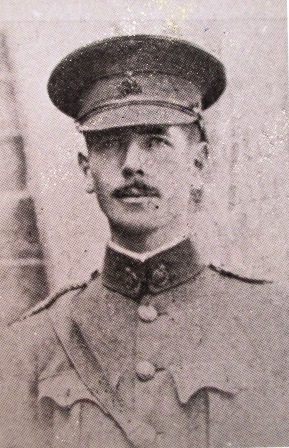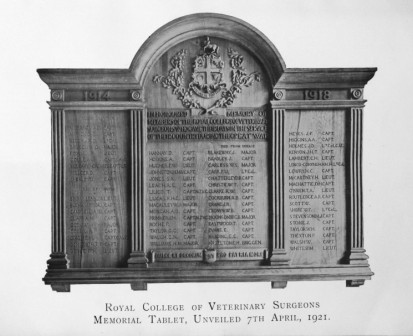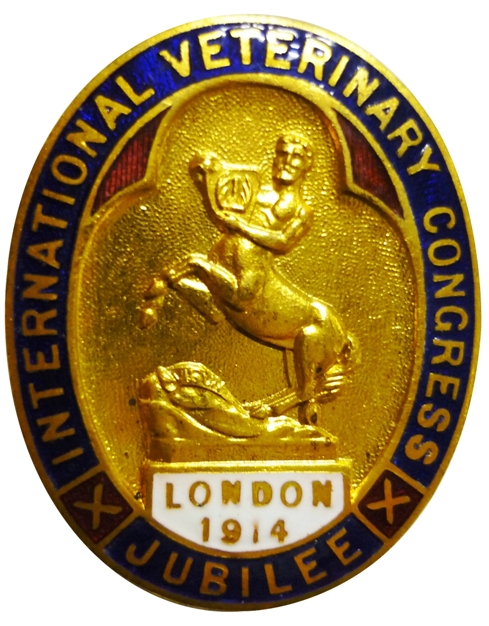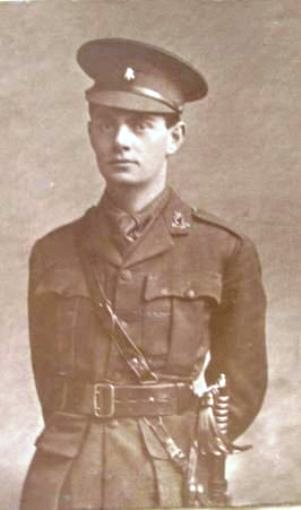A time for reflection: Lieutenant Vincent Fox
Last Friday the Royal College was delighted to accept a portrait of Lieutenant Vincent Fox from his great grand-nephew. Vincent Fox was killed in action on the 26 August 1914: the first member of the RCVS to die during World War 1. His obituary in the Veterinary Record 3 October 1914, simply read:
Vincent Fox, MRCVS, Lieut AVC, Dublin: December 1911
Vincent Richard James Fox (1889-1914) was born at Hacksballscross, Carrickastuck, County Louth. The youngest of 10 children, his father died in 1890, his mother in 1908. The 1911 census shows the family, headed by the eldest son, Patrick, living at 25 Quay Street, Dundalk.
Fox entered the Royal Veterinary College in Ireland in 1907, and graduated MRCVS in December 1911. He initially worked in Dundalk, then in May 1912 he sailed to Calcutta. Here he worked for RS Hart Bros, described as a ‘Royal Horse Repository and Veterinary Infirmary’ by its owner Robert Spooner-Hart MRCVS. The work was varied, ranging from veterinary surgery to horse breeding and dealing; the company also acted as consulting veterinary surgeons to the Calcutta Turf Club. Spooner-Hart died in March 1914, and about that time Fox returned to Ireland, keen to pursue a military career.
Fox received his commission, in the rank of Lieutenant, on probation, in the Army Veterinary Corps, on 31 July 1914. His entrance into the army had obviously moved at quite a pace, since by 22 July he had already obtained his uniform from W T Castle, Military Outfitters of 23 Saville Row, London, for which he was invoiced a total of £22 18/-.
Fox was one of the first veterinary surgeons to depart for France. Serving as Brigade Veterinary Officer to 8 Infantry Brigade he arrived in Boulogne on 14 August. The Brigade were deployed north into Belgium, and by 22 August were at Mons, facing the advancing German army. The position of the British troops meant there was a real risk of their being cut off and on 22 August the order was given to retreat. By 25 August 8 Brigade were positioned in the town of Audencourt, to the east of Le Cateau.
Here the commanding officer deployed the bulk of his troops around Le Cateau to provide support for the men of I Corps as they retreated on his eastern flank. He was ‘advised’ to withdraw but informed the Commander in Chief that he was unable to move any men, and that he had decided to stand and fight.
The Battle of Le Cateau took place on Wednesday 26 August. The headquarters of 8 Brigade were initially sited in a farm in Audencourt, The brigade diary reported that:
No field ambulance and no medical officers being available,
the wounded were taken into the church, a very solid stone structure
and here Lieut V Fox AVC took charge and dressed the wounded.
At about noon the brigade came under a sustained artillery barrage and it was decided to move south. The horses were taken to a nearby orchard; the wounded, being treated by Fox, were to be left in the church, since it was considered strong enough to withstand shell fire. At 2.30pm the Germans commenced a bombardment of Audencourt, with disastrous consequences. Shelling of the orchard led to the death of all the horses and in the late afternoon the church was hit. Witnesses described how the spire was struck, followed by an explosion and the building caught fire. At least one high explosive shell entered the building, causing substantial damage and destruction, resulting in the death of Lieutenant Fox. His family were later to receive reports that his dead body was found, ‘without a mark or scar on it’.
Fox was buried in the Commonwealth War Grave Cemetery at Caudry (British Cemetery) and is commemorated on the RCVS Memorial alongside 66 other MRCVS who died in World War 1
Vincent Fox died whilst treating human, not animal, patients, and in doing so clearly demonstrated his commitment to the treatment of the sick, regardless of species. Although so little was written about his actions at the time in the veterinary press, an obituary in his local paper, the Dundalk Democrat, said that he was:
Killed whilst in pursuit of his humane duty behind the British firing line.
A man could not well die a nobler death.
For more information on the Battle of Le Cateau see The Battle of Le Cateau and subsequent actions via “The Long, Long Trail: the British Army in the Great War (accessed 20/8/2014)
Acknowledgements
I would like to thank Dr Paul Watkins MRCVS for his help in compiling this post.







Leave a Reply
Want to join the discussion?Feel free to contribute!